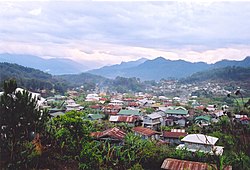Sagada
Template:Infobox Philippine municipality

Sagada is a 5th class municipality in the province of Mountain Province, Philippines. According to the 2000 census, it has a population of 10,575 people in 2,158 households.
It is located 275 km. north of Manila, 140 km. from Baguio, and it is adjacent to Bontoc, the provincial capital.
Sagada is famous for its "hanging coffins". This was a traditional way of burying people that is not utilized anymore. Not anyone was qualified to be buried this way; one had to, among other things, be married and have grandchildren.
Popular activities include trekking, exploring both caves and waterfalls, spelunking, bonfires, picnics, rappelling, visiting historical sites, nature hikes, and participating in tribal celebrations. Guides can be found upon registration at the tourist-office in Sagada Proper (the main town) for a small fee.
Geography
Sagada is nestled in a valley at the upper end of the Malitep tributary of the Chico River some one and a half kilometers above sea level in the central Cordillera; enveloped between the main Cordillera Ranges and the Ilocos Range. Mt. Data in the south and Mt. Kalawitan in the southeast pierce the horizon. Mt. Polis, Bessang and Mt. Tirad in the east, and Mt. Sisipitan in the north mark the Mountain Province - Abra boundary.
Climate and produce
The climate and crops are like those of Baguio and Benguet: cabbage, tomatoes, green pepper, potatoes, carrots, beans, and other temperate products. Between 1882 and 1896, the Spanish colonizers introduced Arabica coffee: a source of income since the American occupation. Citrus, mainly lemon, lime and Valencia oranges were introduced from Spain by Jaime Masferre to provide the needs of American missionaries and employees of the Mission of Saint Mary the Virgin.
Basic culture
Basic culture refers to the indigenous culture before the establishment of a Spanish Mission in 1882. As an ili or village, Sagada was founded by a man, Biyag, from Bika in Eastern Abra. The people from Bika were forced out of their ili by raiding headhunters. Biyag's family resettled in Candon but when baptism or the giving of names was enforced, Biyag's family chose to move back toward the mountains in search for a settlement. Along the way, he and his siblings decided to part ways. A brother, Balay, chose to return to Candon, a sister to Abra. Another brother settled along the upper Abra River. Biyag pushed further to the east until he came to what is now Sagada.
Places of Interest

Sagada has many natural wonders. Backpackers and tourists can enjoy the waters of Bokong and Bomod-ok Falls. Other places that can be visited are:
- Sumaguing and Lumiang Caves
- Bomod-ok and Bokong Falls
- Rice terraces
- Echo Valley
- Kiltepan Tower
- Underground River
- Lake Danum
Accommodation
There are many places to stay in Sagada yet most of these are situated in the main area of town. A notable place to stay at is the A7 house, this is situated in a prime location near the rice terrace and numerous water holes. This house has influenced many individuals and has a rich history. It is operated mainly by a 95 year old who has had 7 kids who grew up there, hence the name A7 house. Another great place is the Canaway Rest House, which recently opened late 2008. A young charming family lives there and they provide a homey feel to the inn. Visitors and tourists may consider the following inns during their stay:
|
|
Barangays
Sagada is politically subdivided into 19 barangays.
|
|
External links
